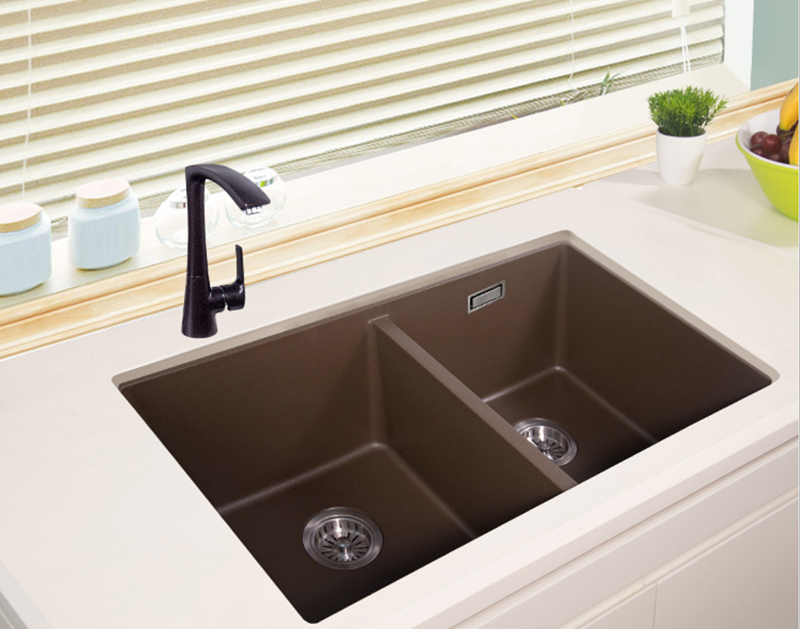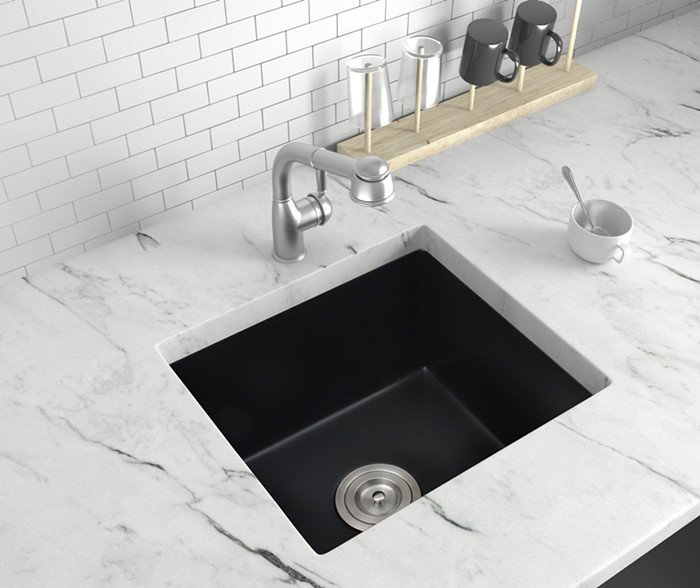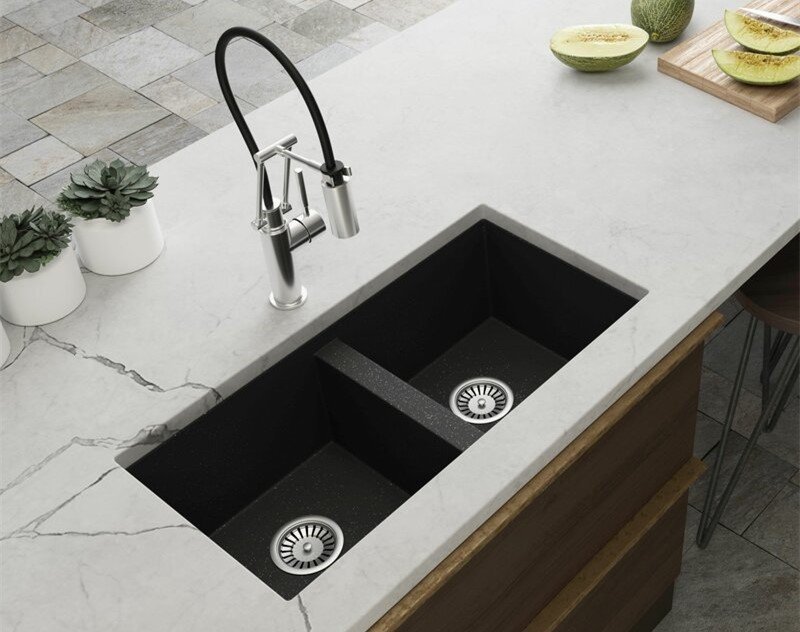A granite composite sink contains various high-quality materials. During the manufacturing process, compounds like quartz sand and resins add to the strength and resilience of the sink. In the end, it is one of the most durable wares. That is why most people make it a top choice for their kitchen.
The answer is straightforward. There is every possibility that a granite composite sink will crack when subjected to hot pots and stress. There are examples where the sink has broken because of the continuous placing of hot metals. It may also get scratches during installation or transport
These basins are durable and long-lasting without issues. But, since nothing is perfect according to Alice walker, granite sinks may yield over time. Many people want to know, can a granite sink crack? Does it get scratches or chips with time?
But often, customers ask – how strong is a granite composite sink? It remains one unanswered question in the world of composite bowls. However, we intend to do justice with this article. Read on to know aside from this, ways by which you can repair a cracked or chipped sink.
How strong is a Granite Composite Sink?
Composite sinks are among the stronger and most durable in the market. This fact is popular among wholesalers and suppliers, but how strong is it? To answer this question to satisfaction, we should consider the components of the granite composite.
During the manufacturing process, several materials go into the production of composite. Some of them are quartz sand, acrylic and plastic dust. These compounds combine to make the resultant composite a strong sink. Hence, it becomes resistant to scratches, chips and stains.
Also, in the finishing process, there is a stage called gel coating. This is where the famous composite glitter comes from. It also helps to keep it free from stains and scratches. Also, during molding, the mixture goes through a process that helps to make it more solid.

The resin helps to bind the quartz together for a stronger composite sink. This compound brings the average density of a granite sink to 2.65g/cm3. Thus, the strength of a granite composite sink is over 200MPa, strong enough to hold a stone without cracking.
Causes of Cracks and Chips on Granite Composite Sinks
Several reasons could cause a crack on a granite composite. It’s a normal expectation since it’s made from sand/stone. So, there are natural causes of damage to these elements as well as human-made dents. Reasons for cracks may range from expansion and contraction of the seal/rod to hot pasta pans. Let’s look at them in detail.
Expansion and Contraction
As you already know, composite sink contains 80% quartz sand which is natural. Since it comes from nature, it can expand and contract when exposed to temperatures. But the sink is an important area in the kitchen, so it always has a hot or cold pan on it.
This action leads to the expansion of the sand when hot and contraction when cold. Moreover, because the sink has been installed, there is no space to expand, hence the crack. What does this mean? Well, the continuous increase and reduction in size due to heat bring about gaps.
Hot Pans
One of the major causes of cracks in composite sinks is hot pans or pots. They undergo some tests after manufacturing to ensure this doesn’t happen, but it does. This is because the sink area is the safest place to go with a hot pot.
And so, it happens so often that the composite materials become weak. The next thing you see is a hairline of crack that begins to increase. However, this doesn’t mean that the sink is not strong, but human activities damage it.
Piling Things on the Sink
This event can take place anytime from the transportation point to the kitchen. Keeping many things on a granite sink for a long time can cause stress. And this affects the strength of the sink due to uneven spread on pressure leading to cracks after a while. Also, avoid the temptation of stepping on the sink top to prevent fissures.
Transportation
When you order granite sinks, the factory transports them to you. During this process of transportation, the products may undergo stress. The bumpy movement of the truck may bring about undue stress on the composite. And this pressure may cause little lines of crack on them.
Normally, even humans may crack under stress. Yet, you can avoid this with excellent packaging tips.
Installation
After buying the sink, you must install it into a kitchen space. You can do this by using simple DIY tips or employing a professional. Whichever way, the process of installation is not an easy one. Moreover, the sinks are bulky and so would require extra assistance for installation.
If this help is not handy, the sink may crack due to excess pressure. Also, it may slip and hit a wall, giving a chance for a crack in the future. That’s why I’ll advise that you hire an expert in the business to handle the installation.

Steps to Repair a Crack on Granite Composite Sink
Granite sinks are reliable and long-lasting. Yet, human actions may endanger it and cause dents. Activities like setting a hot pan on it while cooking or rough handling during installations can lead to cracks. But you can repair them with a quick and easy technique to avoid getting worse.
Once you spot a hairline or crack on your sink, the best thing is to repair it immediately. This move will help to prevent the tear from increasing to something worse or a break. If the crack is tiny you may decide to do it yourself. But if it’s too much, I’ll advise that you call in a professional. Here are the steps.
Step 1 Clean the Area
Ensue the spot of the crack is clean as you don’t start repairs on a dirty sink. Use a mixture of vinegar and heated water solution to wipe the surface. You can make the homemade solution by mixing vinegar and baking soda.
Then, dip a microfiber cloth into the warm water mixture and clean. Make sure you wipe off every dirt to expose the crack well. After a thorough and neat job, allow the surface to dry.
Step 2: Mix Granite Epoxy
Next, you should mix enough granite epoxy for the crack. It’s best to consult the user manual for the exact quantity, depending on the size of the crack. Also, ensure adequate resin and hardener, and allow for five minutes. You may also add color pigment to ensure a neat job afterward.
Step 3: Apply the Epoxy Mixture
Use a small knife or a pallet, to apply the epoxy over the crack in a thorough manner. Ensure you spread over the crack. Use a toothpick to rub it into tiny cracks. Clean off any excess grime on the surface so that it doesn’t harden.
Step 4: Put a Granite Sealer on It
Allow the epoxy to dry, then put a granite sealer on it. This compound enables it to retain its strength after the crack. Leave the sealer to set for like 15 minutes, then apply the last coat. Leave the sink for 24 hours before use.
How Do You Know a Crack, Chip, and Fissure?
These terms are three unalike damages that a granite sink can suffer. Knowing their difference will help you know what steps to take for each one. There are separate ways to treat each, so how do you know a crack, chip, or fissure?
A crack is a line of tear that may run deep into stone, marble, or concrete. This tear may be due to stress caused by temperature increase or movement. Cracks mostly appear on granite areas that are near the sink or cooktop.
The tears occur mostly because these parts have become thinner during installation. Cracks may come in various forms. It could be a slight tear (Hairline) or a separated crack. You should know when to call in a plumber or begin a repair process.

Hairline cracks occur with much ease; maybe due to an installation that has gone wrong. But it doesn’t affect the integrity of the sink and doesn’t need a repair. Then, a separated crack means you can feel the blades of the tear. At this point, you should start fixing it, if not it becomes worse.
A fissure is a long narrow opening on the surface of granite or stone. This line of breakage may not run deep into the sink. But if left unattended may lead to a crack or a chip. Causes of fissures include slight stress on the granite composite sink. This pressure may come from a knock during transport.
A chip, on the other hand, is a small cut or break from the composite material. It takes place at the edge of the sink and may reduce the durability of the composite.
Final World
If you want to find a reliable supplier of granite composite sinks, Chica Dragon is a good choice. They researched the science behind granite composite sinks in great detail. Afterward, they applied this research to make top-quality kitchen sinks.
FILL IN THIS FORM TO REQUEST A QUICK QUOTE FROM CHICA DRAGON
The quality offered by Chica Dragon is unmatched. They only provide superior quality products. Moreover, they also provide OEM service for those Brand manufacturers from all over the world.

